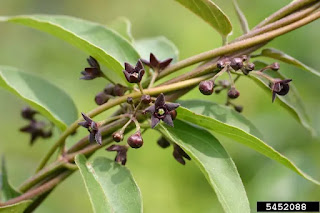Black Swallow-wort in bloom
Black Swallow-wort with seed pods
Black Swallow-wort AKA Vincetoxicum Nigrum
If you ever felt like a meadow sprite tied your feet together while walking through a field, you likely encountered black swallow-wort. It is native to various parts of Europe. The swallow-wort family of plants was once used medicinally as the suffix "wort" in any plant's common name suggests. Black swallow-wort was first imported to the U.S. as an ornamental in Ipswich, Massachusetts in 1854. In my opinion the plant's beauty is questionable. After only ten years in the Ipswich area black swallow-wort was identified as a garden escape. It had already begun to naturalize in the area. Since then, it has spread prolifically throughout New England and far beyond. Today it is considered an invasive plant in states as distant from New England as Wisconsin and California.
Black swallow-wort is a vine that quickly grows into a 3-9-foot-long tangling mass climbing tall grasses and shrubs. The shiny leaves are oval with pointed tips. During the summer, the plant bears clusters of tiny dark purple flowers. As I am writing this it is mid-June, and the flowers are presently in bloom. The entire plant gives off an unpleasant off-putting odor difficult to describe. Once you are familiar with the scent though, you will be able to detect a large infestation of this plant during the intense summer heat using only your sense of smell. After the tiny flowers are pollinated, the plant forms long slender pods containing a great multitude of seeds each with fluffy hairs attached. When the pods burst open these silky hairs act like parachutes, helping to disperse the seeds over long distances. If the seed pod description sounds familiar to milkweed, that is because this plant is a relative. That unfortunate familial connection encourages the monarch butterfly to lay its eggs on black swallow-wort which they mistake for their preferred native milkweeds. When the Monarch caterpillars hatch, they are unable to consume the black swallow-wort foliage, so they perish. Left unchecked, and being yet another invasive plant with allelopathic properties, black swallow-wort is capable of invading an entire field. It crowds out native species such as goldenrod, native milkweeds, asters, etc. Neither deer, or any of our other native wildlife will forage it, and presently there are no insects that consume it. In addition, it is a plant poisonous to domestic livestock. This plant has absolutely no native predators to keep it in check. It is for that reason controlling its spread becomes our job!
HOW TO REMOVE
Removal methods depend upon the scope of the problem. If you are fortunate enough that only a few plants are present, you can dig them out being very careful to remove the entire root system. Unfortunately, new plants will form from any remaining root segments left behind. Trying to pull the plant out without first digging will cause the body of the plant to separate from the roots and regrowth from root segments left behind will readily occur.
Fortunately, most livestock will not consume this plant if it is growing in their pasture. Because of that, in a limited pasture setting, black swallow-wort will grow taller than the other forage material, making it easy to spot. If it is found growing in a lawn or pasture, the plant can be mowed. Repeated mowing will not kill it, but mowing will keep black swallow-wort from forming flowers and resultant seed pods therefore preventing the plant's spread from seed. If you are using mowing as a deterrent be sure to mow during mid to late summer to cut back any seed pods that may have begun to form.
If you are comfortable using an herbicide, a foliar spray using a diluted triclopyr solution, following instructions the product's label, is the recommended method for this plant's eradication. Triclopyr is a broad leaf specific herbicide, so it will not harm adjacent grasses. That means it is perfect for a lawn or pasture. The herbicide should be applied twice during the plant's growth cycle. First in June and again in August after the seed pods have developed. In my opinion black swallow-wort is among the most difficult invasive plants to eradicate. Unfortunately, in the section of Scotland where I live the fields have become inundated with this invasive plant, and if it is not kept at bay, I fear it will overtake the entire Waldo valley!
A potential ray of hope is a biological control method first introduced in 2018. The larvae of a moth called Hypena opulenta, was found munching on black swallow-wort in Ukraine. The moth was introduced in several carefully monitored areas including some in Connecticut. The moth's larvae greedily consume the mature leaves of the black swallow-wort plant. UCONN Extension is one of the institutions experimenting with this biological control method, and these moths have been released as near as Stonington, Connecticut. Unfortunately, biological control using Hypena opulenta moths is still in its experimental stages. The moths are not yet available to the public. As you can imagine, biological control of invasive plants brings potential risks. The introduction of a new foreign species is not entirely predictable. In this case as with others, if the biological control is deemed safe and effective, it could help to keep the use of foliar herbicides to a minimum, proving to be the lesser of two weevils. To date the black swallow-wort plants in the meadows all around me, here in the Waldo valley, are all lush and healthy and growing with great gusto. I have not observed a single hole in any of their leaves. The Hypena opulenta moths and their larvae have not yet arrived in Scotland. I am keeping my fingers crossed that they will arrive soon.


No comments:
Post a Comment